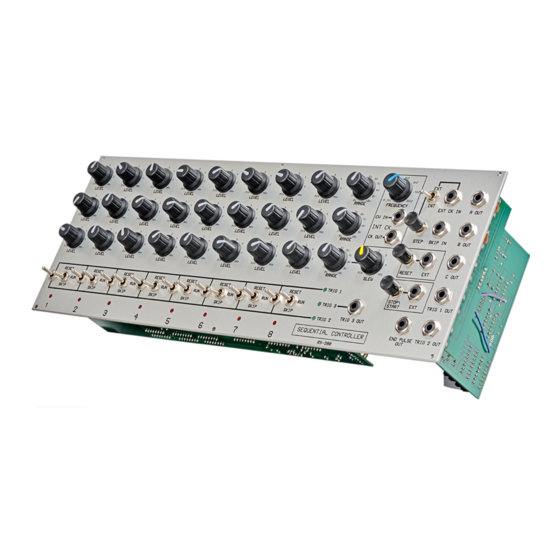
Advertisement
Quick Links
3 X 8 STEP SEQUENTIAL CONTROLLER
INTRODUCTION
It's tempting to compare analogue sequencers to hardware MIDI sequencers, both rackmount and
computer-based, if only because they are all capable of producing repetitive sequences and effects that
can be modified in real-time. But, while a hardware MIDI sequencer can look like its analogue counterpart,
it lacks one important facility inherent to analogue voltage control: you can't add multiple MIDI controllers
or use audio signals as modulators to create new effects.
Unfortunately, vintage analogue sequencers from companies such as ARP and Korg sell for hundreds of
pounds, and you'll be lucky to get change from £1,000 if you want an original Moog sequencer. Worse
still, these originals are becoming increasingly rare, and by modern standards they can be rather limited.
This is why the RS Integrator has a dedicated analogue sequencer, the RS200. Not only does it eliminate
the need for a vintage unit if you want to create sequences with the Integrator itself, the RS200 will (with
an RS10 or RS15 case) function as a self-contained unit capable of controlling almost all other analogue
monosynths.
IN USE
The RS200 is by far the most complex module within the RS Integrator series. Its key features are:
•
Three rows of 8-step CV generators with individual CV ranges and CV outputs for each row
•
Independent trigger outputs for each of rows 1, 2 and 3
•
Internal clock with external CV input and clock output
•
External clock input and manual step function
•
Slew generator for portamento and other effects
•
Skip, Reset, and Stop/Start functions with independent CV inputs
•
End of sequence pulse output
•
LEDs to indicate sequence position and trigger status on each step
To aid understanding about each of these we will divide this chapter into four parts, as follows:
1.
Quick Tour
2.
The Sequence Steps
3.
Inputs, Outputs, And Other Controls
4.
Some Ideas To Get You Started
82
RS200
ANALOGUE SYSTEMS RS-INTEGRATOR
Advertisement

Summary of Contents for ANALOGUE SYSTEMS RS200
- Page 1 This is why the RS Integrator has a dedicated analogue sequencer, the RS200. Not only does it eliminate the need for a vintage unit if you want to create sequences with the Integrator itself, the RS200 will (with an RS10 or RS15 case) function as a self-contained unit capable of controlling almost all other analogue monosynths.
-
Page 2: Quick Tour
RS200 to control an external synthesiser please make allowances for the different names and configurations that you might encounter. Connect the A OUT output on your RS200 to the CV-IN of an RS90 VCO or the CV-IN 1V/oct input of your external synth. - Page 3 These set the voltage created by Row C at each step of the sequence. Their range is 0V to +10V, but their operation is modified by the Row C RANGE control (see below). The Switches: (iv) RESET/RUN/SKIP switches The eight switches each offer 3 basic functions: ANALOGUE SYSTEMS RS-INTEGRATOR...
- Page 4 Note: A trigger is produced at the TRIG 3 OUT on every step regardless of all other settings. Amongst other uses this acts as a 'trigger THRU' socket when the RS200 is clocked from an external source. The Step Indicators...
- Page 5 Trigger 1 CV C Slew rate Trigger indicators Trigger 2 Trigger 3 Buttons Inputs: End of Row Pulse output Internal Clock output Step Internal Clock rate Reset External Clock input Stop/Start Skip Step input External Reset External Start/Stop ANALOGUE SYSTEMS RS-INTEGRATOR...
- Page 6 The RS200's I/O panel offers a total of 13 sockets, of which five are inputs and eight are outputs. There are also five knobs, three buttons, one switch and three LEDs. Together these can control many aspects of a synthesiser ’s operation, including but not limited to: pitch control, filter frequency modulation, and the timing of events.
- Page 7 CV IN, the internal clock will not exceed its minimum and maximum rates of 0.1Hz and 30Hz. EXT CK IN This input accepts signals with 'ON' amplitudes in the range +1V to +20V and 'OFF' amplitude of less ANALOGUE SYSTEMS RS-INTEGRATOR...
- Page 8 There is no practical limit to the frequency of the input signal. One advantage of this is the ability to clock the RS200 at audio frequencies, making it possible to use each of the three rows in the sequencer as an audio-frequency complex waveform generator.
- Page 9 Of course, there’s no room to do more than scratch the surface of the RS200's possibilities in this manual, so remember: an open mind and some free experimentation can yield startling results. Here are some basic ideas: Set your RS200 and synthesiser up as described in the QUICK TOUR.
- Page 10 Just as an analogue synthesiser has an infinite number of possibilities, so does an analogue sequencer. The seven ideas above merely give you an idea of the types of sounds and effects you can create with the RS200. The rest is up to you! ANALOGUE SYSTEMS RS-INTEGRATOR...

Need help?
Do you have a question about the RS200 and is the answer not in the manual?
Questions and answers